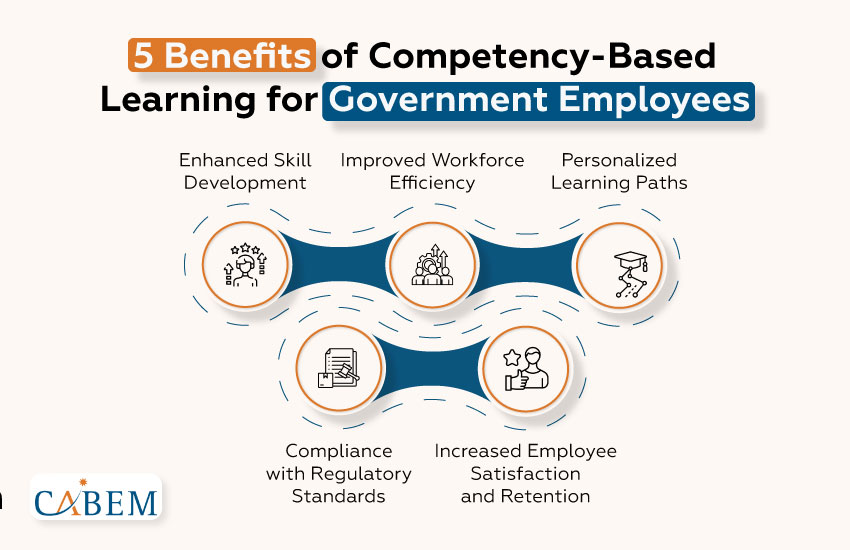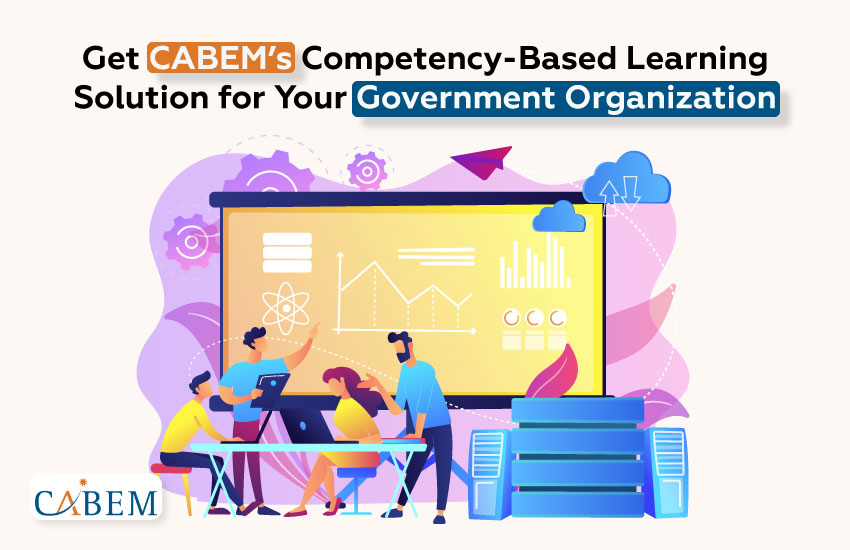Training is a crucial process in any government institution that enables the organization to enhance skills and maintain an effective and compliant workforce. Unfortunately, the global and professional demands of government employees in the modern world are challenging to accomplish by simply training them the conventional way.
With the unpredictable changes that come with technological advancement, regulatory frameworks constantly evolve, and new challenges seem more complicated to tackle.
Competency-based learning (CBL) provides a pattern-breaking solution focused on demonstrating competency in specialized skills and competencies for a more robust, more agile workforce.
However, how does this approach fit into the government context, and why should organizations consider adopting it?
This article focuses on competency-based government training, its challenges, and how CABEM solutions can help your team overcome these issues.

What is Competency-Based Learning in the Government Context?
Competencies-based learning (CBL) within a government context refers to performance measures of specific, quantifiable skills and behaviors that an employee in government agencies requires to be effective.
Contrary to conventional classroom training methods, which approach training as a requirement for the time spent in classes or completion of particular modules, CBL focuses on performance and potential.
When working in governmental institutions, the assignments may require understanding regulations, communicating, working under stress, or new technological trends. All these competencies are, in fact, the requirements of the area of service. Thus, every employee could satisfy the organization and the citizens.
- According to research, 70% of workers say they would be at least somewhat inclined to quit their current position to work for a company renowned for investing in training and developing its personnel. However, more prospects for career growth were the driving force behind 34% of workers who quit their prior positions. (LORMAN)
Would you like to discover how competency-based learning management systems (CBLMS) can improve or completely overhaul your workforce training? Our blog, “6 Key Benefits of Competency-Based Learning Management Systems,” dives into why these systems are crucial for modern organizations.
Learn how they alleviate skill gaps, ensure conformity, and increase staff participation while yielding favorable outcomes.

Challenges in Traditional Government Employee Training
Traditional government employee training programs often depend on rigid, outdated methods that must be revised to meet modern workforce demands.
Here are some common challenges:
- Lack of Personalization: Off-the-shelf training modules do not cater to employees’ specific requirements and knowledge of pre-existing skills, creating inefficiencies.
- Time Constraints: Employees are sometimes mandated to conduct training during the day, which affects daily operations.
- Compliance Issues: Many training programs must adequately address evolving regulatory requirements, leaving employees and organizations vulnerable to non-compliance.
- Limited Measurement of Progress: Traditional methods often lack robust tools to track skill acquisition or identify gaps in employee competencies.
- Engagement Problems: Long, monotonous training sessions can result in low employee engagement and retention of material.

How Competency-Based Learning Overcomes These Challenges
Competency-based learning solves these issues by emphasizing measurable outcomes and offering customized training pathways.
Here’s how:
- Personalized Learning: All workers go through their bespoke learning roadmap, and each will advance at a different pace, focusing only on areas that need additional skill development.
- On-the-Job Application: CBL focuses on real-world applications, ensuring the training is always relevant.
- Compliance-Ready: CBL ensures that every employee fulfills regulatory requirements and possesses required certifications through automated tracking and robust frameworks.
- Data-Driven Insights: Comprehensive analytics provides a complete overview of employee performance, identifies skill gaps, and assesses the success of training modules.
- Engagement-Oriented: Employees engage with the content much more and retain a better memory of what they have learned through interactive and hands-on methods.
- According to a new study, organizations utilizing competency-based models achieve a 63% increase in role-specific skill-building over traditional training approaches. (Source: International Labour Organization (ILO))

5 Benefits of Competency-Based Learning for Government Employees
Competency-based learning (CBL) is not just another form of training; it’s a tactical approach to workforce development that prepares employees for real-world challenges.
What if we had a system where every government employee went through role-specific training tailored to avoid wasteful use of their time and create employees ready to be skilled for their role in government organizations and public needs?
CLB establishes an environment of continuous learning, encouraging innovation and accountability across departments. But how can your organization harness these gains fully to drive performance and enhance public service delivery?
With CBL, government agencies can close the gap between training and meaningful, performance-based action. Ready to take the next step?
Want to learn more about the strategies that drive workforce excellence? Check out our blog, “Managing Skills to Transform Organizational Success,” to explore how effective skill management complements competency-based learning, ensures lasting organizational impact, and takes your team’s development to the next level!
1. Enhanced Skill Development
Competency-based learning emphasizes skill mastery, ensuring employees develop the expertise required for their roles. This approach fosters a more profound understanding and robust skill set.
- Focuses on both technical and soft skills critical to government roles.
- Incorporates real-world scenarios to apply knowledge effectively.
- Provides measurable benchmarks for skill progression.
2. Improved Workforce Efficiency
Government organizations can enhance workforce productivity by training employees in competencies directly tied to job responsibilities.
- Reduces time spent on irrelevant or redundant training.
- Identifies and closes skill gaps promptly.
- Aligns training outcomes with organizational objectives.
3. Personalized Learning Paths
CBL tailors the training experience to each employee, accommodating their existing skills, career goals, and learning pace.
- Allows employees to skip content they’ve already mastered.
- Provides flexibility to learn during convenient times.
- Enhances motivation through a focus on individual strengths.
4. Compliance with Regulatory Standards
Compliance with regulatory frameworks is one of the main components of government functioning. CBL keeps employees aware of important laws and policies.
- Tracks certifications and licenses seamlessly.
- Automates compliance reporting for audits.
- Incorporates industry standards into training frameworks.
5. Increased Employee Satisfaction and Retention
Employees are more willing to participate in training that aligns with their career and self-development objectives, which enhances job satisfaction and retention rates.
- Offers clear pathways for professional development.
- Builds confidence through demonstrated competency achievements.
- Reduces turnover by fostering a culture of learning and growth.

4 Key Features of CABEM’s Competency-Based Learning Solution for Government
CABEM’s solution for competency-based learning addresses some traditional training limitations by helping government organizations align to the needs and directions driven by modern organizational dynamics.
With awareness around skill building, compliance tracking, and progress analysis, our platform helps with continuous innovation, improvisation, and flexibility. Now, envision a system that detects those gaps and provides personalized pathways and actionable insights to close them.
How can your agency benefit from a solution that evolves with your workforce? CABEM ensures that your training programs are not just effective today but adaptable for the challenges of tomorrow.
1. Customizable Competency Frameworks
CABEM’s solution allows organizations to define and implement competencies tailored to specific roles and departmental needs.
- Supports the creation of competency models unique to your agency.
- Adapts frameworks to accommodate evolving job requirements.
- Integrates seamlessly with existing training programs.
2. Automated Skill Gap Analysis
The system shows what skills employees lack and where targeted training interventions should focus on actionable insights.
- Identifies what is lacking within teams at an individual worker level and the entire team.
- Generates customized learning paths to address gaps.
- Reduces time and resources spent on unnecessary training.
3. Comprehensive Reporting and Analytics
CABEM’s platform offers robust tools to measure progress, track certifications, and demonstrate compliance.
- Features real-time dashboards for tracking learning outcomes.
- Generates audit-ready reports for regulatory reviews.
- Enables data-driven decision-making to optimize workforce development.
4. Integrated Compliance Management
Regulatory compliance is simplified with built-in tools to monitor, track, and manage credentials and certifications.
- Automates reminders for certification renewals.
- Tracks compliance with industry-specific standards.
- Ensures alignment with legal and policy requirements.

Get CABEM’s Competency-Based Learning Solution for Your Government Organization
Is your agency ready to revolutionize workforce training? Driven by the unique government organization’s need, CABEM has created solutions enabling competency-based learning. Our proprietary platform allows skill enhancement, regulatory compliance, and employee satisfaction.
Whether identifying skill gaps or real-time and audit-ready reporting — CABEM equips your team with everything you need to succeed. Outdated training should not hold your organization back! Are you going to have a motivated, compliant workforce in the future?
Contact us today to learn how CABEM can revolutionize your training programs!
FAQs
What are examples of competencies relevant to government employees?
Government employee competencies comprise good communication, compliance with laws and regulations, analytical thinking, use of digital technology, leadership skills, and decision-making. Such competencies also ensure that employees have the skills to serve public demands and organizational objectives well.
What limitations exist in current government training programs?
Traditional training programs often need more personalization, flexibility, and robust compliance tracking. They also struggle to keep employees engaged and fail to measure skill acquisition effectively.
What makes CABEM’s solution unique for government needs?
CABEM offers a fully customized competency-based learning platform, compliance management, and real-time reporting capabilities. It aims to address government organizations’ unique compliance and operational challenges.
Is the solution scalable for larger government organizations?
Yes, CABEM’s solution is scalable to accommodate agencies of any size. Its customizable frameworks and cloud-based hosting options make it suitable for both small teams and large governmental bodies.

